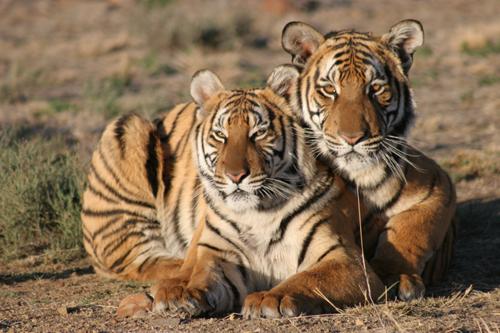Inbreeding threatens survival of China tigers
As Chinese people are embracing the arrival of the Year of Tiger on Saturday, zoologists are worried about the survival of South China Tigers as the endangered species are facing a serious problem of inbreeding.
|
|
| File photo: South China Tigers |
No traces of the tigers have been found in the last decade, they said.
The number of captive South China tigers (Panthera tigris amoyenesis) rose to 92 in 2009 from 60 in 2007 but all the tigers were the offsprings of six wild South China tigers which were caught more than 40 years ago, said Deng Xuejian, a professor with the Department of Biology of Hunan Normal University, based in Changsha, capital of central China's Hunan Province.
"The inbreeding may lead to genetic freaks, low survival rates and poor physical makeup," Deng said.
All the genes have come from two male and four female tigers, which had lead to highly identical genes in the offspring, Deng said.
"The situation may reduce the genetic diversity and cause degradation or even the extinction of the species," he said.
The tigers would lose genetic diversity if their genes were too similar, said Ma Zaiyu, president of veterinary hospital of Changsha Zoo.
"The number of the members of a species should be at least 1,000 to maintain the stability of the species," Ma said.
Zoologists estimated the number of wild South China tigers could have been less than 30 in the 1990s. The remaining wild tigers are presumed to live in the remote areas of Guangdong, Hunan, Fujian and Jiangxi provinces, Deng Xuejian said.
Based on analysis of relevant date combining field investigation, Deng estimated the number of wild South China tigers could be less than 10.
No traces of wild South China tigers were reported in Hunan in the last two years, said Zhou Shuhuai, director of wildlife protection section of the Hunan provincial forestry bureau.
"The number is limited and the tigers scatter in different areas, which make it difficult for natural breeding between wild tigers," said Huang Gongqing, a tiger expert at South China Tiger Breeding Base in Suzhou, a city of east China's Jiangsu Province.
"The extinction of the wild tigers will happen sooner or later," Huang warned.
Some experts have said that there may be already no wild South China tigers. "However, we cannot know as the animal is very difficult to trace," Deng said.
Ma Zaiyu said to avoid extinction of the species, more captive tigers should be bred, and some genes might be recovered when the population reaches 1,000, while Deng suggested continuous search for wild tigers to enrich the captive tigers' genes.
The situation is much better for the Siberian tigers (panthera tigris altaica) in northeast China as the number of the wild ones is quite stable, experts said.
The number maintains at around 20 in China, among which 10 to 14 are in Heilongjiang Province and eight to ten are in Jilin Province, said Sun Haiyi, deputy director of Heilongjiang Wildlife Institute
"But no more young tigers under one year old have been discovered in the past two years. The reason might be the number of female tigers are less than the males and the animals are relatively isolated by the mountains," Sun said.
China established a breeding base for the Siberian tigers in Heilongjiang in 1986 and the number of captive tigers has increased from eight to current more than 800, Sun said.
Experts called for more efforts to protect the habitats of the tigers for the purpose of protection and re-wilding of the tigers.
 0
0 








Go to Forum >>0 Comments